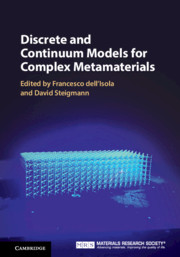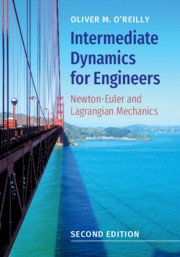Refine search
Actions for selected content:
8126 results in Fluid dynamics and solid mechanics
ONE-DIMENSIONAL CHAOTIC LAMINAR FLOW WITH COMPETITIVE EXOTHERMIC AND ENDOTHERMIC REACTIONS
- Part of
-
- Journal:
- The ANZIAM Journal / Volume 62 / Issue 4 / October 2020
- Published online by Cambridge University Press:
- 15 April 2020, pp. 423-445
-
- Article
-
- You have access
- Export citation
THE VALUE OF COMMUNICATION AND COOPERATION WHEN SERVERS ARE STRATEGIC
- Part of
-
- Journal:
- The ANZIAM Journal / Volume 61 / Issue 4 / October 2019
- Published online by Cambridge University Press:
- 06 April 2020, pp. 349-367
-
- Article
-
- You have access
- Export citation
Index
-
- Book:
- Discrete and Continuum Models for Complex Metamaterials
- Published online:
- 20 February 2020
- Print publication:
- 12 March 2020, pp 395-398
-
- Chapter
- Export citation
Frontmatter
-
- Book:
- Discrete and Continuum Models for Complex Metamaterials
- Published online:
- 20 February 2020
- Print publication:
- 12 March 2020, pp i-iv
-
- Chapter
- Export citation
5 - Lagrangian Discrete Models: Applications to Metamaterials
- from Part II - Mathematical and Numerical Methods
-
- Book:
- Discrete and Continuum Models for Complex Metamaterials
- Published online:
- 20 February 2020
- Print publication:
- 12 March 2020, pp 197-262
-
- Chapter
- Export citation
Part II - Mathematical and Numerical Methods
-
- Book:
- Discrete and Continuum Models for Complex Metamaterials
- Published online:
- 20 February 2020
- Print publication:
- 12 March 2020, pp 139-140
-
- Chapter
- Export citation
1 - Metamaterials: What Is Out There and What Is about to Come
- from Part I - Designing Complex (Meta)Materials: Results and Perspectives
-
- Book:
- Discrete and Continuum Models for Complex Metamaterials
- Published online:
- 20 February 2020
- Print publication:
- 12 March 2020, pp 3-51
-
- Chapter
- Export citation
Contents
-
- Book:
- Discrete and Continuum Models for Complex Metamaterials
- Published online:
- 20 February 2020
- Print publication:
- 12 March 2020, pp v-vii
-
- Chapter
- Export citation
3 - Pantographic Metamaterial: A (Not So) Particular Case
- from Part I - Designing Complex (Meta)Materials: Results and Perspectives
-
- Book:
- Discrete and Continuum Models for Complex Metamaterials
- Published online:
- 20 February 2020
- Print publication:
- 12 March 2020, pp 103-138
-
- Chapter
- Export citation
List of Contributors
-
- Book:
- Discrete and Continuum Models for Complex Metamaterials
- Published online:
- 20 February 2020
- Print publication:
- 12 March 2020, pp viii-x
-
- Chapter
- Export citation
2 - A Review of Some Selected Examples of Mechanical and Acoustic Metamaterials
- from Part I - Designing Complex (Meta)Materials: Results and Perspectives
-
- Book:
- Discrete and Continuum Models for Complex Metamaterials
- Published online:
- 20 February 2020
- Print publication:
- 12 March 2020, pp 52-102
-
- Chapter
- Export citation
6 - Experimental Methods in Pantographic Structures
- from Part II - Mathematical and Numerical Methods
-
- Book:
- Discrete and Continuum Models for Complex Metamaterials
- Published online:
- 20 February 2020
- Print publication:
- 12 March 2020, pp 263-297
-
- Chapter
- Export citation
Part I - Designing Complex (Meta)Materials: Results and Perspectives
-
- Book:
- Discrete and Continuum Models for Complex Metamaterials
- Published online:
- 20 February 2020
- Print publication:
- 12 March 2020, pp 1-2
-
- Chapter
- Export citation
8 - Least Action and Virtual Work Principles for the Formulation of Generalized Continuum Models
- from Part II - Mathematical and Numerical Methods
-
- Book:
- Discrete and Continuum Models for Complex Metamaterials
- Published online:
- 20 February 2020
- Print publication:
- 12 March 2020, pp 327-394
-
- Chapter
- Export citation
4 - Naive Model Theory: Its Applications to the Theory of Metamaterials Design
- from Part II - Mathematical and Numerical Methods
-
- Book:
- Discrete and Continuum Models for Complex Metamaterials
- Published online:
- 20 February 2020
- Print publication:
- 12 March 2020, pp 141-196
-
- Chapter
- Export citation
7 - Variational Methods as Versatile Tools in Multidisciplinary Modeling and Computation
- from Part II - Mathematical and Numerical Methods
-
- Book:
- Discrete and Continuum Models for Complex Metamaterials
- Published online:
- 20 February 2020
- Print publication:
- 12 March 2020, pp 298-326
-
- Chapter
- Export citation
APPROXIMATION OF AND BY COMPLETELY MONOTONE FUNCTIONS
- Part of
-
- Journal:
- The ANZIAM Journal / Volume 61 / Issue 4 / October 2019
- Published online by Cambridge University Press:
- 06 March 2020, pp. 416-430
-
- Article
-
- You have access
- Export citation
A SEMI-ANALYTICAL PRICING FORMULA FOR EUROPEAN OPTIONS UNDER THE ROUGH HESTON-CIR MODEL
- Part of
-
- Journal:
- The ANZIAM Journal / Volume 61 / Issue 4 / October 2019
- Published online by Cambridge University Press:
- 06 March 2020, pp. 431-445
-
- Article
-
- You have access
- Export citation

Discrete and Continuum Models for Complex Metamaterials
-
- Published online:
- 20 February 2020
- Print publication:
- 12 March 2020

Intermediate Dynamics for Engineers
- Newton-Euler and Lagrangian Mechanics
-
- Published online:
- 08 February 2020
- Print publication:
- 30 January 2020
-
- Textbook
- Export citation
